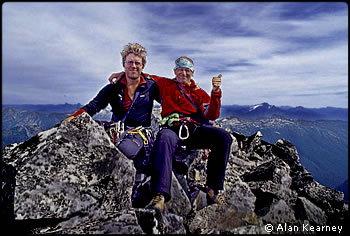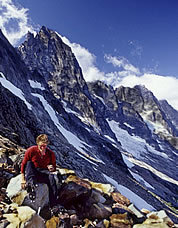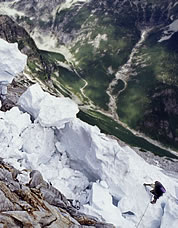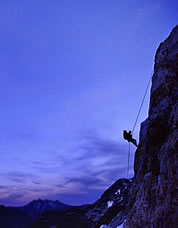|
|
|||||||||
 |
||||||||||
 |
||||||||||
|
||||||||||
It should be apparent to the reader by now that a quiver of fresh partners is required to fuel an obsession like this one. When a shaft is spent, one reaches deeper for a lithe, strong and talented climber, as sharp as an arrow. The bow was a bit creaky, but I still had the fanaticism for the elusive line on the 2400-ft buttress of compact metamorphic rock. Various injuries prevented me from climbing in 2007, but I hadn’t stopped thinking about McMillan, figuring out exactly what gear to take, how much to carry up the route, when to get the best window of weather, and above all, “who” to entice to go along. Enter on the scene Erik Johnson, a 30-year-old who joined me for an attempt on Poincenot in Patagonia in February of 2008. If one has the patience to sit under a windy, dusty, cold boulder for a week in Patagonia without climbing, they certainly are Pickets material. During August we were both either climbing or working. Forget Labor Day since it rains 99.9% of the time, and that left the second week of September. Sure the days would be getting shorter and the nights chillier, but what about moisture? The prediction actually looked good for eight or nine days, with possible showers on only one day. By now I was so familiar with the Sourdough approach that I knew all the best campsites, all the wrong turns, and every boulder, tree, bush, and clump of moss. As a result we made the final camp on the ridge near the spires in two comfortable days, with time to spare for a nap. That night the rains came, allowing time for a Scrabble tournament the following day. On day four the skies cleared as we traversed the remnants of the McMillan Creek Glaciers over to the start of the Northeast Buttress. Thanks to the effort with Matt two years earlier, Erik and I made a good bivy ledge that night after seven pitches of climbing. The ledge was the same that Matt and I had used before, so little preparation was needed. The site had one tenant who seemed overjoyed at our arrival. Probably the same bushy-tailed Woodrat that tried chewing on our gear before was at it again. Like a slum-dwelling scavenger who is expert at dodging the authorities and projectiles, our crafty rodent was no exception.
Here I was again on this magnificent North Cascades-bastion of unclimbed rock wondering if this time we would make it. Several pitches above rose the dark brooding overhangs that had dogged me for 17 years; what mysteries did the rock hold, what secrets were sequestered in the tiny flower clumps and lichen-clogged fissures? Even though the weather was dry, dampness pervaded everything on the shadowed north-facing wall, making certain that even sticky rubber wouldn’t feel sticky enough. Erik and I stashed nearly half our bivy gear, and a day’s worth of water and food from a garbage bag under an overhang, in hopes of challenging the resident rodent. This time the rack was bit heavier than before as it included a small bolt kit. The larger cams aren’t much use in the Pickets since wide cracks are scanty, but a varied collection of the small metal spikes are very handy. I got the first long pitch above our first night’s open-air encampment. The alpine hammer pick made a fine gardening tool, and had I brought some Geranium seeds, Erik and I could have turned McMillan into a Swiss tourist attraction. The day was looking like another fine one as Erik led up a perfect corner to “familiar” looking overhangs. Once at the belay I had that distinct feeling I had been there before. A sense of Deja Vu gripped me as I made an airy traverse to an exposed belay below what we thought might prove the crux pitch. A rusty pin and old faded sling on a rounded horn greeted me at the stance. With a shout I yelled to Erik: “Damn someone has already been here… and I think it was me.” Like old friends, the two pieces of gear again reminded me of my off-route adventure with Paul Sloan in 1991. Once I had anchored to several bugaboos and stacked the rope, I brought Erik over. A quiet tenseness consumed us both; this definitely looked to be the hardest bit. “Want the bolt kit Erik?” I asked. Erik looked up, then at his rack, then up again. Silence. Then he answered with an uncertain, “Nooo.” One is acutely aware of the remoteness and lack of help when attempting hard moves on a big alpine route, and any accident is going to become a serious affair. Erik took his time working his way up on small face holds, getting in an occasional small cam or Stopper until a point where any vestige of fissure, pocket, or flake disappeared. He had several moments of contemplation, and then continued edging and smearing up and rightward across blank rock with his eye on a rounded and crumbly flake that might take pro. It did, shakily. In another ten feet he reached real cracks again, and worked higher to a belay. With the shout, “I’m off!” we both breathed easier. Erik was clearly the man to do these climbs with; his calm approach to a very serious pitch was the key to us finishing the route. In several more leads and near sunset, we reached another one of my vacation time-shares, the bivy ledge Dana and I slept on in 2002. It had the vital ingredients a recreation spot needed: level place to sleep, great view, and hot water. Since the pack had been put on a radical diet that morning, sleep would be chilly and our dinner a hobo’s special. But the night was starry, the hardest climbing below us, and the summit 11 pitches above. After 14 pitches of new climbing, we were now on the North Buttress route, and familiar territory. “Shall we take a pack to the top?” asked Erik clutching his mug of instant java, his eyes barely open. “Nah!” I replied. “I know the way and we’ll be back here by early afternoon. A few whispy clouds mocked me, but they didn’t look substantial. With a windshirt tied around the waist, a couple granola bars, knife and tiny headlamp in our pockets, we were off. The final chapter was about to be written, and I wanted to have fun by keeping it lightweight.
The summit was ours in just a few hours, and unlike the recent stock market, my obsession had finally paid dividends. From that first glimpse of the McMillans, all the Picket climbs and adventures, and every attempt on the buttress, my dream had been realized. For Erik, the teetering blocks on the airy top of East McMillan Spire were the vindication of many attempts on big routes without a summit. Below us the deep blue of Azure Lake scintillated in the afternoon sun, the jagged summits of West McMillan, Inspiration, Degenhart, Terror, Fury, and Luna rose to meet the sky, and a gentle breeze cooled the air. That calm moment allowed us to enjoy the surroundings without hurrying or having much trepidation about the descent. Later in camp, as Erik watched the evening skies glow orange and then red over McMillan, I wrote a poem about our last view of the mountain we had climbed.
|
|
|
|
||||||||||||||||||||||||||||||
| << Previous | 1 | 2 | 3 | |||||||||||||||||||||||||||||||||
| ©2009 Northwest Mountaineering Journal | |||||||||||||||||||||||||||||||||
| Site design by Steve Firebaugh | |||||||||||||||||||||||||||||||||





